2024 NFL Draft: How three trends in pro football connect to this year's prospect class
The nature of professional football is perpetually changing. This continuous strategic battle between offensive and defensive coordinators introduces and phases out various game plans. Consequently, this influences the characteristics of incoming players, mirroring alterations made at the lower levels of the sport and influencing the makeup of each positional group.
As the 2024 NFL Draft approaches, the team at Next Gen Stats has analyzed several significant trends that could indicate the future direction of the game and how teams may prioritize prospects in this year’s class.
1) Prospects are getting lighter and faster
At the NFL Scouting Combine earlier this year, Texas receiver Xavier Worthy put on an electrifying display of speed, setting a new record in the 40-yard dash with a time of 4.21 seconds. The exhilarating performance of the 165-pounder highlights the trend of prospects becoming lighter and faster, especially at his position.
Since 2003, wide receivers participating in the combine have run increasingly faster in the 40-yard dash, but no receiver class has been quicker than the 2024 crew, which just set the event on fire. In fact, the class clocked the fastest average 40 time (4.44) of any WR group over the last two decades. It’s important to note that not every NFL hopeful participates in the combine or in every drill; this year, for example, top prospects Marvin Harrison Jr. and Malik Nabers both skipped testing. Only 30 receivers ran the 40 at the combine in 2024, the second fewest by any WR class since 2003. That said, nine of them (30 percent) ran it in under 4.40 seconds; that’s the highest percentage by any receiver class.

When analyzing speed, it is also crucial to factor in weight. In addition to being the fastest receiver class, the 2024 crop is the second lightest, averaging 196.1 pounds — lighter than the 2003 class by over 6 pounds. This is not just a one-year anomaly, either. The last four draft classes have featured the four lightest wide receiver groups since 2003. From 2003 to 2020, 820 wide receivers were invited to the combine. Only 25 of them (3 percent) weighed 175 pounds or less. Over these last four draft classes (including the 2024 group), the percentage of players checking in below that weight threshold has more than doubled, to 8.3 percent, with 15 total receivers weighing in at 175 pounds or less.
The trend extends well beyond the wide receiver position. The past few classes of quarterbacks, running backs, tight ends, edge defenders, linebackers and safeties have all been among the lightest over the past two decades. The only positions that have bucked the trend are in the trenches: offensive linemen and defensive tackles. While lighter and faster edge defenders might be more explosive as pass rushers, they can become a liability when trying to set the edge in the run game. Similarly, new-look linebackers will be more equipped for coverage than taking on blocks and fitting the run.
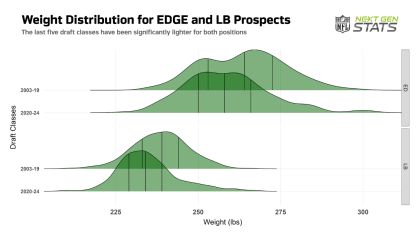
Since the beginning of the decade, there has been a significant change in the weight distributions of edge rushers and linebackers, with both groups now averaging nearly 5 pounds lighter. Between 2003 and 2019, over half of the linebackers entering the NFL weighed more than 239 pounds. However, in the last five draft classes, only a quarter of linebackers have met this weight. Similarly, edge rushers who weighed more than 265 pounds used to represent almost half of the prospects entering the league. Yet, they too have experienced a similar decline in weight over the recent five draft classes.
This year’s class of edge defenders have an average weight that is 1.7 pounds lighter than any other class since 2003, placing the linebackers as the second-lightest class in that period. Both classes have also clocked the second-fastest average 40 times at their respective positions.
Edge defenders and linebackers entering the NFL have gotten lighter and faster over the last four draft classes.
Both position groups in this year's class were among the top 2 lightest classes over the last two decades:
EDGE: 255.3 lbs (lightest)
LB: 231.8 lbs (2nd) pic.twitter.com/mDS54y678R— Next Gen Stats (@NextGenStats) March 1, 2024
The top four edge rushers in Daniel Jeremiah’s latest ranking of the top 50 prospects in the 2024 class (Dallas Turner, Jared Verse, Laiatu Latu and Chop Robinson) all weighed in under 260 pounds and clocked a sub-4.65 40. Payton Wilson, who is Jeremiah’s second-ranked linebacker this year, recorded a 4.43-second 40 at the combine. That places him in the top five among all linebackers to run at the combine since 2003.
2) QBs are taking longer to throw — but throwing shorter passes
In 2023, the average time for non-play-action pass attempts hit a new record, representing the longest duration in the past eight seasons.
Rewriting the note: It’s important to note that evaluating the time taken to throw on play-action passes is complicated due to their specific timing and characteristics. By removing play-action attempts from our study, we can provide a more precise comprehension of the elements contributing to the extended time to throw.
In 2016, Tyrod Taylor was the only quarterback to average more than 2.80 seconds on non-play-action attempts. In 2023, there were 10 QBs to top that mark, including league MVP Lamar Jackson, Super Bowl MVP Patrick Mahomes and Offensive Rookie of the Year C.J. Stroud. The group of 10 quarterbacks with a time to throw over 2.80 seconds in 2023 was the biggest in the Next Gen Stats era (since 2016). On the other side of the spectrum (and opposite the league trend), Tua Tagovailoa got the ball out at a rapid pace, as his time to throw on such passes this season was the quickest in the Next Gen Stats era.
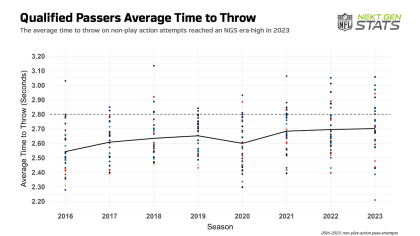
Caleb Williams, who is widely presumed to be the first overall pick in this year’s draft, will enter a league that is much more suited to his skill set than it would have been in years past. Williams held onto the ball for 3.16 seconds before throwing on average in his final college season, the third-longest time to throw of any Power 5 quarterback, according to Pro Football Focus. Even just a few years ago, scouting staffs across the league might have wondered whether his free-wheeling play style would translate to the pros. Any such concerns have likely been tempered by the success of quarterbacks who are comfortable playing out of structure in the modern NFL.
Apart from Tagovailoa’s record-breaking throwing time last season, it’s clear why the average time to throw reached an all-time high in the NGS era in 2023. There was a 5.6 percentage point drop in the quick-pass rate (the rate of passes thrown under 2.5 seconds) from 2016 to the current season. This reduction in quick-pass rate is partly due to quarterbacks extending plays more than ever. Over the same period, the extended-pass rate (the rate of passes thrown over 4.0 seconds) increased by 3.4 percentage points.
There has also been an increase in plays where the QB takes an extended time to throw. In 2016, there were 517 pass attempts where the time to throw exceeded 5 seconds. Last season, this number increased to 615, nearly 100 more attempts. This has significantly contributed to the increased time to throw observed over the past eight seasons.
One could assume that quarterbacks perform better as they lengthen plays and retain possession of the ball. However, evidence based on completion percentages suggests otherwise. Examining completion percentages for extended passes over the past six years reveals that quarterbacks in 2022 and 2023 had the lowest and second-lowest records, respectively. This was also true in terms of yards per attempt. In contrast, the completion percentage for quick passes has remained steady since 2018, consistently around 73 percent annually.
While average time to throw has been steadily increasing, the league-average air-yards-per-attempt has been decreasing, a counterintuitive trend that has taken shape over the past few seasons.
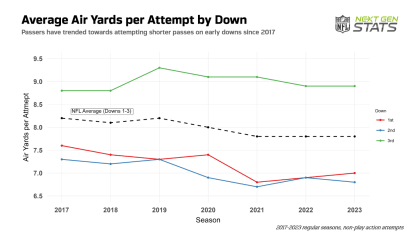
When breaking down how average air yards per attempt has changed season-to-season by down, it becomes more apparent that quarterbacks have shifted their aggressiveness in certain scenarios, specifically on early downs. It is not surprising that air yards per attempt have held fairly steady on third downs from season to season, given that quarterbacks are required to be aggressive by the do-or-die nature of the situation. (Average air yards per attempt on non-play-action third-down passes remained between 8.9 and 9.1 yards in five out of six seasons since 2017.) On early downs, however, there has been a steady decline in aggressiveness. In 2017, the average air-yards-per-attempt figure was 7.6 yards on first down and 7.3 yards on second down, both of which stand as the highest single-season marks over the past seven seasons. In each of the past three seasons, though, average air yards per attempt failed to surpass the 7.0-yard threshold on first and second downs.
Some elite young quarterbacks have followed this trend. Patrick Mahomes, Joe Burrow and Josh Allen have all thrown the ball roughly a yard-and-a-half closer to the line of scrimmage on average since their third seasons as starters compared to their first two. This could be a sign of maturity, that they are learning to take the checkdown for easy yardage and matriculate the ball down the field.
| Patrick Mahomes | Joe Burrow | Josh Allen | |
|---|---|---|---|
| 2018-19 | 8.9 | 8.5 | 10.1 |
| 2020-23 | 7.5 | 6.9 | 8.5 |
A few of the top quarterback prospects from this year’s draft class were very aggressive pushing the ball downfield in their final collegiate season. Per PFF, Drake Maye averaged 11.0 air yards per attempt and Michael Penix Jr. averaged 10.7, both ranking in the top 10 among Power 5 quarterbacks (minimum of 200 attempts). Heisman Trophy winner Jayden Daniels was close behind them, throwing the ball on average 10.5 yards down the field. It is reasonable to assume that aggression is likely to continue as the quarterbacks transition to the pro game, as it will take time to develop patience and be willing to take open windows underneath.
Bo Nix stands as the outlier. Nix leaned on the quick game in college, averaging the third-quickest time to throw (2.44 seconds) among Power 5 quarterbacks during his last season at Oregon. As a result, he averaged just 6.8 air yards per attempt. Only one Power 5 quarterback with at least 200 attempts (Graham Mertz) threw the ball closer to the line of scrimmage.
We don’t know exactly how these prospects will fit into the trend, but we can try to connect some dots as to why NFL QBs are taking more time to make shorter throws. Let’s start with some defensive changes. Likely in an effort to limit big plays, NFL defenses used zone coverage on 71.6 percent of plays this past season, the highest rate in a season since 2018. Additionally, the league-wide split-safety rate — which was 33.7 percent in 2018 — has increased in five consecutive seasons, all the way to 42.1 percent in 2023.

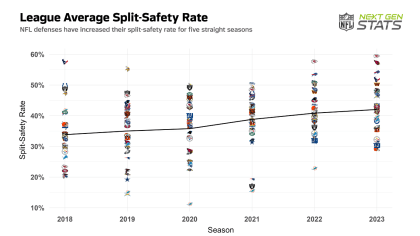
It’s no surprise that as defenses implement a keep-everything-in-front-of-them strategy, average time to throw has increased. Since 2018, the league-wide average time to throw against zone coverage is 2.80 seconds, a full tenth of a second longer than the time to throw against man coverage (2.70 seconds). And this also explains the decrease in depth of target on early downs. QBs likely aren’t holding on to the ball longer because they’re getting time to let plays develop and rip it downfield; rather, they’re reacting to defenses that sell out to limit downfield success. QBs are then likely taking checkdowns more frequently because that is what defenses are allowing for.
This seemingly paradoxical association is perfectly embodied by Patrick Mahomes. Last season, Mahomes set a record for his career’s slowest throw time and least air yards per attempt. Consequently, he was the first among 228 suitable passers since 2017 to achieve a throw time exceeding 2.90 seconds and an average of less than 7.0 air yards per attempt.
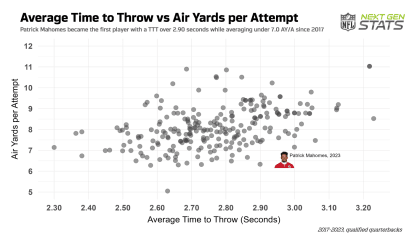
3) The Shanahan effect is real
The influence that Kyle Shanahan (and his father, former NFL coach Mike Shanahan) have on the NFL is often discussed. But beyond compiling a list of coaches who have worked for or with either Shanahan, is it possible to quantify their impact? What does the Shanahan effect actually look like?
To respond to that inquiry, we should begin by looking at shifts and motions, tools utilized by coaches to expose defensive strategies, create advantageous mismatches, and strategically position offensive players.
In 2016, the majority of NFL offenses used shifts or motions minimally, with an average of 38 percent of plays incorporating them. The Atlanta Falcons, however, were an exception to this trend. Under the direction of offensive coordinator Kyle Shanahan, they led the league by using shifts or motions in 61 percent of their plays. Their high-scoring offense led them to the Super Bowl that year. Subsequently, Shanahan was hired by the 49ers as their coach and they consistently led the NFL in shift/motion usage from 2017 to 2021, coming in second in 2022 and 2023. As a result, the overall use of shifts/motions in the league has increased each year, reaching a high of 54 percent in 2023.
Which coach bested Shanahan in shift/motion usage over the past two seasons? You guessed it: former Shanahan assistant Mike McDaniel. With McDaniel as their head coach, the Dolphins used shift/motion on 78 percent of plays in 2022 and 80 percent in 2023, with the latter figure setting a new record for a team in the NGS era (since 2016). Compare these figures to Miami’s usage of shift/motion before McDaniel; in the six seasons prior to McDaniel’s hiring (2016-2021), the Dolphins employed shift/motion on 44 percent of offensive plays, peaking at 56 percent in 2021.
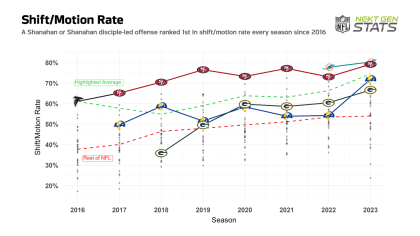
As expected, Miami set a new NGS single-season record in 2023 by gaining a massive 2,955 yards through shift/motion. Shanahan’s 49ers were not far behind with 2,887 yards. Notably, other teams coached by former associates of Shanahan also made it to the top 10. The Rams, under Sean McVay, were fifth in terms of yards and third in usage rate at 71.9 percent. Matt LaFleur’s Packers also performed well, ranking seventh in yards and sixth in usage rate, recording a percentage of 66.7.
The 2024 NFL Draft will feature one of the deepest and most dynamic wide receiver classes in recent memory, and one of the top prospects in particular was featured heavily in pre-snap motion at the college level, to help get the ball in his hands and create mismatches. Malik Nabers, the fourth-ranked prospect on Daniel Jeremiah’s big board, gained 239 receiving yards after being used in a motion last season (fifth-most in the Power 5), according to PFF. He went in motion on 57 routes, ranking in the top 15, and picked up 12 first downs on such routes (third-most).
Shanahan and his followers appear to be influencing another significant trend: the deliberate use of condensed formations and narrow formation widths. These condensed formations generate more open field, compelling cornerbacks to adopt an outside leverage to safeguard this open field.
The narrative mirrors that of shifts/motion. In 2016, NFL offenses typically utilized condensed formations 11 percent of the time. However, Shanahan’s Falcons surpassed this average significantly, employing condensed formations in 25.4 percent of plays, second only to the Titans who used them 30 percent of the time. Shanahan has consistently increased his use of condensed formation each season since 2016, reaching a record single-season high of 63.9 percent in 2023 during the NGS era. The Niners also became the first team to have an average formation width of less than 20 yards in a season since 2016, recording a figure of 19.9. Unsurprisingly, the league-wide rate of condensed formations has surged, reaching 30 percent in 2023. Concurrently, the league-wide average formation width has decreased by nearly 4 full yards since 2016, from 28.3 to 24.6.
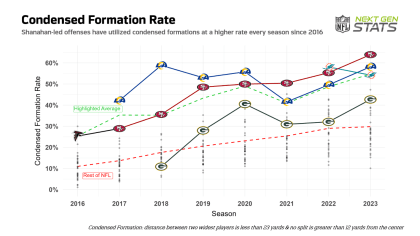
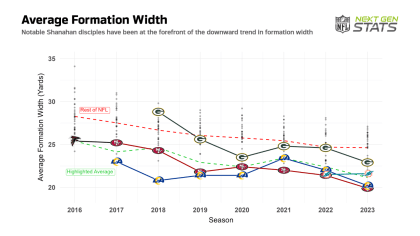
Looking at the top performers in the use of condensed formations over the past few seasons, it’s unsurprising to see the prevalence of associates from Shanahan’s team. The Rams, under McVay, topped the NFL in this area from 2017 to 2020, were third in 2021-22, and second the following season. The Dolphins, led by McDaniel, were the NFL leaders in 2022 and came in third in 2023. LaFleur’s Packers secured third place in 2020 and fifth in 2023. In fact, including the Texans last season (with Shanahan’s former assistant Bobby Slowik serving as their offensive coordinator) and the Jets in 2021 (who had Shanahan’s former assistant Mike LaFleur, Matt LaFleur’s brother, as their offensive coordinator), either Shanahan or a colleague of his accounted for 18 of the top 20 single-season condensed usage rates since 2016.
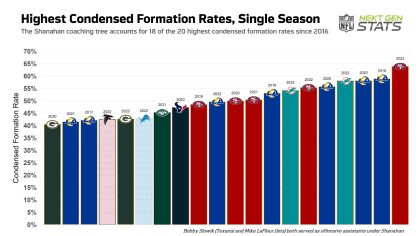
That’s not to say everyone in this group approaches the game exactly the same way. Each coach adjusts to maximize their team’s roster construction, as illustrated by a divergence in offensive formations. The Rams led the NFL in usage of 11 personnel (94.6 percent of plays) in 2023, while the 49ers (38.8 percent) and Dolphins (44.4 percent) used 11 personnel at the second and third lowest rates, respectively. On the other hand, Miami (42.2 percent) and San Francisco (36.2 percent) topped the NFL in usage of 21 personnel, while the Rams were one of four teams to not record a single play in the formation last season.
Nonetheless, upon examining the statistics, it is undeniable how Shanahan and his peers with similar views are influencing the league.
Chace Daskalos & Jack Habegger contributed to this article.


